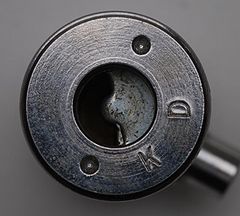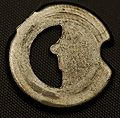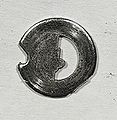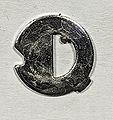Abloy Profile
Abloy Profile / High Profile
| Abloy Profile / High Profile | |
 | |
| Name | Abloy Profile / High Profile |
|---|---|
| Manufacturer | Abloy |
| Lock Type | Cylinder |
| Lock Design | Disc-detainer |
| Year(s) Produced | 1977 - 2000 |
| Related Locks | |
| Abloy Classic Abloy Disklock Abloy Exec Abloy Sento | |
The Profile (or High Profile) is a disc-detainer lock made by Abloy. The Profile uses between 5 and 14 discs that interface with a sidebar. The High Profile is a modified version of the standard Profile that allows for extended master keying capabilities. Profile models are easily identified because they use a "C" shape keyway.
The Profile and High Profile are a newer form of the Abloy Classic, and both have since been superceded by many other models, the latest of which is the Abloy Easy.
Principles of operation
|
|
Abloy literature refers to the plug as the "cylinder" and the cylinder as the "housing". Lockwiki uses the traditional terms to avoid confusion. |
The Profile works by using angled bitting cuts on the key to properly rotate discs. The key is inserted and rotated 90°; the angled cuts on the key then rotate the discs in the lock. If all the discs are rotated to the correct position the sidebar can fall into the discs and the plug can be rotated. Washers are placed between discs to ensure that the key rotates each disc individually.
There are six positions available for discs, at 18° increments between 0° and 90°. In a fourteen disc lock, there are 7,836,164,096 (614) theoretical key differs.
Discs provide manipulation resistance in the form of false gates. In addition, they may use a modified cut-out shape to deter the use of improperly shaped tools.[1] The first disc in the lock is made of hardened steel and is free-floating. This provides drill resistance as well as lockpicking resistance.
The sidebar may be round (padlocks and cam locks) or L shaped (furniture locks).
Notes
- The first disc (hardened steel) is always a 0 cut (90°).
- Master keying is made possible by multiple true gates cut on each disc.
- The patent for Profile/High Profile keys expired in 1999.
High Profile
The High Profile version allows extended master keying in the form of control discs within the lock. Each control disc has warding that interacts with a limited portion of the key. For a key to be fully inserted it must match the warding of each control disc as it is inserted into the lock. This does not prevent lockpicking attacks directly, but it may deter the use of a tool being easily inserted into the keyway.
Disassembly instructions
Disassembly of the Abloy Profile is fairly simple, though care must be taken to ensure that removal of the discs is done properly. Discs cannot be flipped around and the order of washers must be preserved to ensure proper function once reassembled.
Padlocks
Note: The shackle must first be released via a key or other method of entry to non-destructively disassemble Abloy padlocks.
- Unlock the lock and release the shackle.
- With an allen wrench, unscrew the cylinder retaining screw (Hole on the side, near the bottom. Releasing the shackle clears this area.)
- Lock the shackle and remove the key.
- With the bow end of the key, unscrew and remove the cylinder faceplate.
- Remove the plug and sidebar. Holding the disc stack with a key is recommended.
Cam locks
- Remove the cam.
- With a flathead screwdriver, remove the C-clip by lightly tapping counter clockwise.
- Remove the plug and sidebar from the back of the cylinder.
Vulnerabilities
The Profile and High Profile may be vulnerable to one or more of the following:
Gallery
References
- ↑ Fey, Han. 2004. Discs make the difference.












